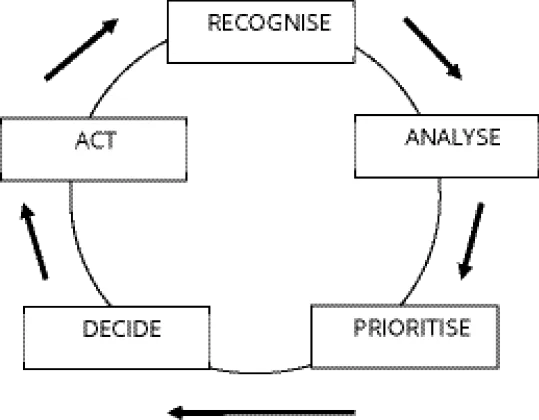![]()
Part 1
Cognitive Airmanship
![]()
Chapter 1
Introduction to Airmanship
At a fundamental level Airmanship is related to and underpins aircrew performance. High levels of Airmanship are required for high levels of performance. Consequently, a comprehensive understanding of all aspects of Airmanship is required if aircrew performance is to be improved. Airmanship is that element of flying, from the planning stage to debrief, that deals with effective application of knowledge and skill, both mental and physical, in the operation of the aircraft. Although some elements of Airmanship are assimilated through experience most can be taught and assessed. Those that are gained through experience require structured ‘post flight’ analysis through debriefing to be effective. Fundamental to good Airmanship is the ability to think clearly, which requires mental capacity. An adult’s mental capacity cannot be increased therefore it is vital to ensure that an individual maximises this capacity through effective utilisation of each separate skill within airmanship. Failure to do so may lead to inadequate spare capacity remaining to learn new skills or perform additional tasks. Due to its multi-faceted characteristics Airmanship can best be defined as ‘The Art of Operating the Aircraft’ which means that some areas of Airmanship are more relevant to some aircraft and/or roles than to others.
‘The Art of Operating the Aircraft’ as an overarching definition is adequate but does not give any detail as to the specific areas that go to make up Airmanship. Studies have shown that Airmanship is predominately a cognitive skill associated with behaviour best modelled on a ‘Decision-Action’ loop. The most famous ‘Decision-Action’ loop is the OODA loop – Observe, Orientate, Decide, then Act - which was created by Col John Boyd, USAF to help teach and understand Air Combat Training (ACT) in the 1960s. The underlying performance premise being that whichever pilot ‘actioned’ their OODA loop fastest would dominate the fight and eventually win. This was expanded by the Royal Air Force to the RAPDAR loop – Recognise, Analyse, Prioritise, Decide, Act then Review – to better describe the behaviour associated with Airmanship. To Clarify:
a. RECOGNISE significant factors or events
b. ANALYSE likely effects of the recognised events or factors and project possible action.
c. PRIORITISE multiple events, factors or analyses
d. DECIDE on most appropriate action
e. ACT on the decision
f. REVIEW/REPEAT process
Fig 1.1 RAPDAR Loop
The Review phase is critical as it allows for data and analysis validation and caters for a changing and dynamic situation. If the Review is not carried out there is no chance to correct errors made in analysis or accommodate and process new data. The Review also allows one to check if the action has had the required effect and take account of any time limits. A good example of the impact of neglecting the Review is the infamous incident of the Airbus 330 which had to divert and land ‘engines out’ in the Azores. The flight deck crew analysed an indicated fuel imbalance as a difference in fuel burn between engines and, as dictated by the aircraft emergency check-list, opened the fuel cross-feed to correct this. No review was carried out and the true cause of the fuel imbalance – a massive fuel leak – was not diagnosed until a low fuel problem became evident. By this time the impact of the incorrect diagnoses and subsequent actions meant that the aircraft engines would flame-out before a landing could be accomplished. Luckily, due to the exceptional skill of the pilots, a safe glide landing was carried out with minimal damage to the aircraft and no injuries to the passengers.
Once the ‘Decision-Action’ format was established specific areas could be identified that make up Airmanship. These are:
a. Situational Awareness
b. Mental Performance
c. Decision Making
d. Communication
e. Resource Management
f. Spare Mental Capacity
Although ‘Situational Awareness’, ‘Mental Performance’ and ‘Decision Making’ are given separate headings there is significant overlap between them. All areas can be taught and assessed and are dealt with in detail in later chapters.
![]()
Chapter 2
Basic Psychology Underpinning Aircrew Performance
Introduction
In broad terms Psychology deals with the ‘Why, What & How’ of human behaviour. As performance is another way of describing behaviour a basic understanding of some fundamental psychological principles is required when dealing with aircrew performance and airmanship. The scope is wide, but the level of understanding is basic and for this the simple...

